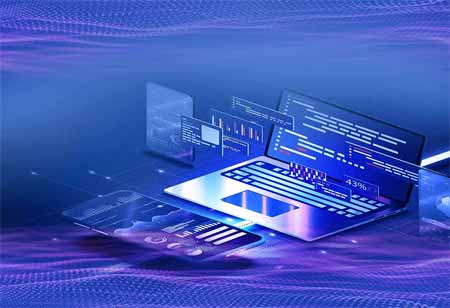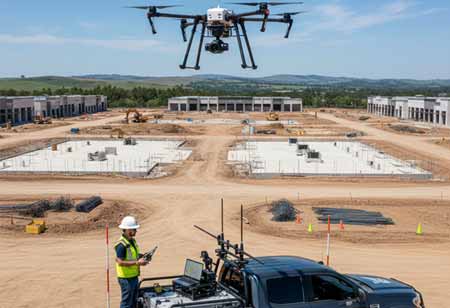THANK YOU FOR SUBSCRIBING
Be first to read the latest tech news, Industry Leader's Insights, and CIO interviews of medium and large enterprises exclusively from Applied Technology Review
Drone Delivery: A Game-Changer for Logistics
In the rapidly evolving logistics domain, drone delivery is emerging as a transformative technology by reshaping how goods are transported and delivered

By
Applied Technology Review | Tuesday, January 28, 2025
Stay ahead of the industry with exclusive feature stories on the top companies, expert insights and the latest news delivered straight to your inbox. Subscribe today.
Drone delivery is transforming logistics, driven by technological progress, regulatory improvements, and environmental advantages. With the rise of specialized designs and AI-powered systems, numerous investment opportunities are emerging.
FREMONT, CA: The logistics industry is evolving quickly, and drone delivery is really making a difference in how we move and deliver goods. With better drone technology, new rules coming into play, and a growing need for speed and efficiency, the future of logistics is becoming clearer. It's likely that using drones for deliveries will soon be the norm.
The Evolution of Drone Delivery
Leveraging drones for deliveries is not a novel concept, but recent technological advancements have driven it from an idea to a tangible and viable solution. Early drone delivery trials prioritised small payloads and short distances. However, contemporary drone delivery systems are tailored to carry larger loads over longer distances, positioning them as practical for diverse industries.
Multiple companies have been at the forefront of testing and implementing drone delivery systems. These companies have invested heavily in research and development to mitigate challenges encompassing battery life, payload capacity, and regulatory hurdles. As a result, drones are now capable of delivering packages to remote locations, minimising delivery times significantly.
Advancements in Drone Technology: One of the prominent drivers behind the future of drone delivery is the continuous improvement in drone technology. Modern drones are equipped with sophisticated features.
Autonomous Flight Systems: Autonomous Flight Systems have revolutionised drone operations, eliminating the need for manual control. Modern drones employ advanced AI-powered software for autonomous navigation. This encompasses path planning, where drones analyse real-time data to determine the most efficient route by considering factors such as weather conditions and terrain. Sophisticated sensors like LiDAR and radar allow obstacle avoidance, making a 3D map of the surroundings. Drones detect and navigate around potential hazards like buildings and power lines. Additionally, AI-driven algorithms enable drones to make real-time decisions, responding adeptly to unexpected scenarios such as sudden changes in wind speed or the emergence of obstacles, bolstering safety and operational efficiency.
Sense-and-Avoid Technology: Sense-and-Avoid technology stands pivotal in guaranteeing the safety of drones, especially in shared airspace with conventional aircraft. Drones employ a multi-layered sensor system for comprehensive situational awareness:
LiDAR, leveraging pulsed lasers, generates a precise 3D map of the environment, effective even in low-visibility scenarios. This technology boosts the drone's capability to discern and navigate challenging surroundings. Radar extends detection capabilities beyond LiDAR, identifying objects like other drones or aircraft and tracking their movements. Complementing these technologies, cameras visually confirm obstacles and surroundings, contributing to informed decision-making. Together, this sensor fusion creates a robust safety net, enabling drones to navigate through varied conditions with elevated awareness and reliability.
Battery Technology: Battery technology is paramount in overcoming the historical challenge of limited flight time in drone deliveries, ushering in transformative changes. Developments in this field encompass increased energy density, particularly with the advent of lithium-ion polymer batteries. These newer batteries store more energy per unit weight, enabling drones to cover longer distances and transport heavier payloads.
The introduction of faster charging technologies lowers downtime between deliveries, significantly boosting operational efficiency. Intelligent battery management systems further streamline energy consumption by enabling drones to adjust their power usage based on flight paths and payload, guaranteeing maximal range and minimising the risk of mid-flight power depletion. These innovations collectively drive the feasibility and viability of drone deliveries.
Traffic Management Systems: As the skies become increasingly populated with drones, the development of robust traffic management systems (TMS) is imperative for ensuring both safety and efficiency. These systems are designed to track and monitor drone movements in real time, providing authorities and other drones with awareness of each other's locations to prevent collisions.
Analogous to designated highways for cars, TMS can establish dedicated air corridors for drones, allowing them to navigate without interference with manned aircraft. Furthermore, AI-powered systems automate conflict resolution by analysing potential clashes between drones and suggesting adjustments to their flight paths. This sophisticated approach guarantees the smooth and collision-free operation of the expanding drone ecosystem.
Furthermore, the incorporation of artificial intelligence (AI) in drone systems has improved their capability to adapt to evolving environments, make split-second decisions, and streamline delivery routes. This ensures that drone deliveries are fast and adaptive to real-time conditions, positioning them as a reliable option for various logistics scenarios.
Regulatory Developments:
The growing adoption of drone delivery hinges on establishing clear and standardised regulations. Governments around the world are proactively working on building frameworks that balance the potential advantage of drone technology with safety and privacy concerns.
Regulatory bodies have been collaborating with industry stakeholders to develop guidelines for drone operations. This encompasses rules for drone certification, flight paths, altitude restrictions, and communication standards. As these regulations become more refined, the drone delivery environment will gain the necessary structure to support widespread implementation.
Economic and Environmental Impact:
Drone delivery has the potential to bring about significant economic and environmental advantages. Minimising delivery times and optimising routes empower businesses to bolster their operational efficiency. The ability to reach remote areas with ease opens up novel markets and opportunities for enterprises, particularly in regions with underdeveloped infrastructure.
The excitement surrounding drone delivery transcends mere speed and convenience; it signifies a leap towards a more environmentally sustainable future. In contrast to conventional delivery methods, drones present a compelling avenue for curbing carbon emissions and lessening the ecological footprint of logistics.
Efficiency through Electric Power: Drones, relying majorly on electric batteries, stand in stark contrast to fuel-consuming trucks and vans. This converts into zero tailpipe emissions, a significant advantage in combatting air pollution and greenhouse gases. Research indicates that drones emit up to 94% lower greenhouse gases per package than diesel trucks, surpassing the efficiency of electric vans.
Last-Mile Excellence: Conventional delivery often includes multiple transportation modes, each contributing to the carbon footprint. Drones excel in last-mile delivery, directly reaching customers from warehouses or distribution centres. This eliminates the need for additional ground transportation, reducing emissions and alleviating traffic congestion.
Precision and Optimisation: Drones, equipped with advanced navigation and route planning software, optimise delivery routes, minimising unnecessary travel and energy consumption. Furthermore, their capacity to navigate directly to precise locations lessens detours and minimises fuel wastage.
Expanding Beyond E-commerce: The environmental benefits of drone delivery extend beyond online shopping. Essential sectors encompassing healthcare, emergency response, and disaster relief leverage drones for swift and efficient deliveries, often reaching locations inaccessible through conventional means. This serves to diminish the environmental impact of these critical operations.
Investment Opportunities
The drone industry is growing, and its global market is projected to reach a staggering $101.1 billion by 2032. This significant rise presents exciting investment opportunities across diverse sectors, driven by several key trends.
The era of the one-size-fits-all drone is replacing by a surge in specialised designs customised for particular purposes. Agriculture drones, equipped with precision sensors, monitor crop health, precisely apply pesticides, and gather data for precision farming, boosting efficiency and sustainability in agriculture. Inspection drones, armed with high-resolution cameras and sensors, inspect critical infrastructure such as bridges, pipelines, and wind turbines, enhancing safety and minimising maintenance costs. Security and surveillance drones, leveraged for border patrol, crowd monitoring, and security patrols, raise privacy concerns that require careful consideration and regulation.
The software and data aspects of drone technology are equally important. Advanced software platforms and data analytics are integral to traffic management systems that manage airspace, prevent collisions, and ensure safe drone operations. Drones, acting as data collectors, generate valuable information on crop health, traffic patterns, and more. Companies are developing AI-powered platforms to analyse this data, offering actionable insights for various industries. However, the growing reliance on software and data also demands an emphasis on cybersecurity to secure drone systems from hacking and cyber threats.
The investments in drone technology are diverse. Investors are exploring publicly traded companies like DJI, Parrot, and AeroVironment, which provide direct exposure to the industry's growth. Venture capital and private equity firms are actively investing in startups at the forefront of drone technology and software development. For those seeking indirect exposure, exchange-traded funds (ETFs) tracking the performance of companies in robotics, automation, and aerospace offer a clear view of the wider technological environment, encompassing the drone industry. The dynamic nature of drone technology and its expanding applications present promising opportunities for investors across diverse market sectors.
I agree We use cookies on this website to enhance your user experience. By clicking any link on this page you are giving your consent for us to set cookies. More info








